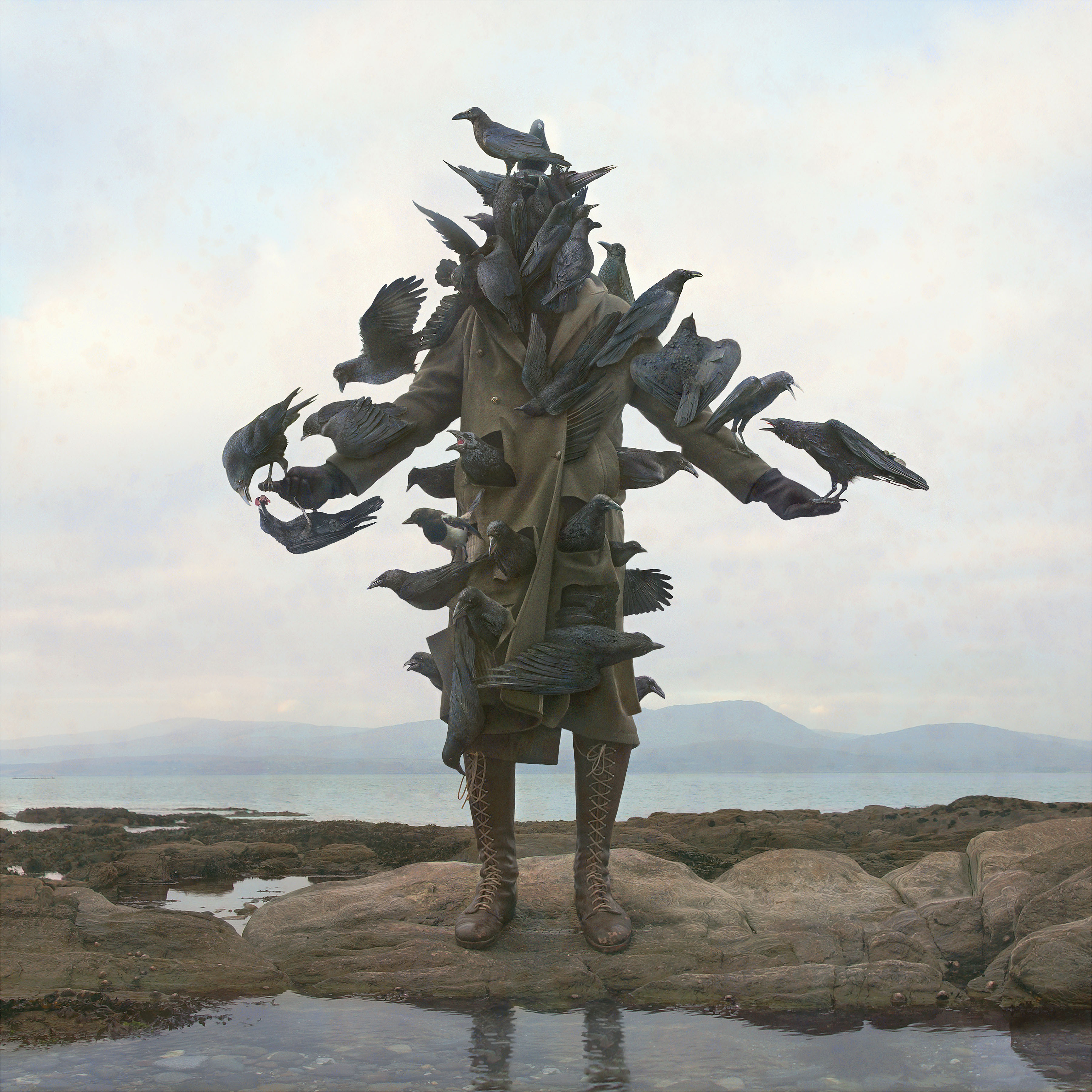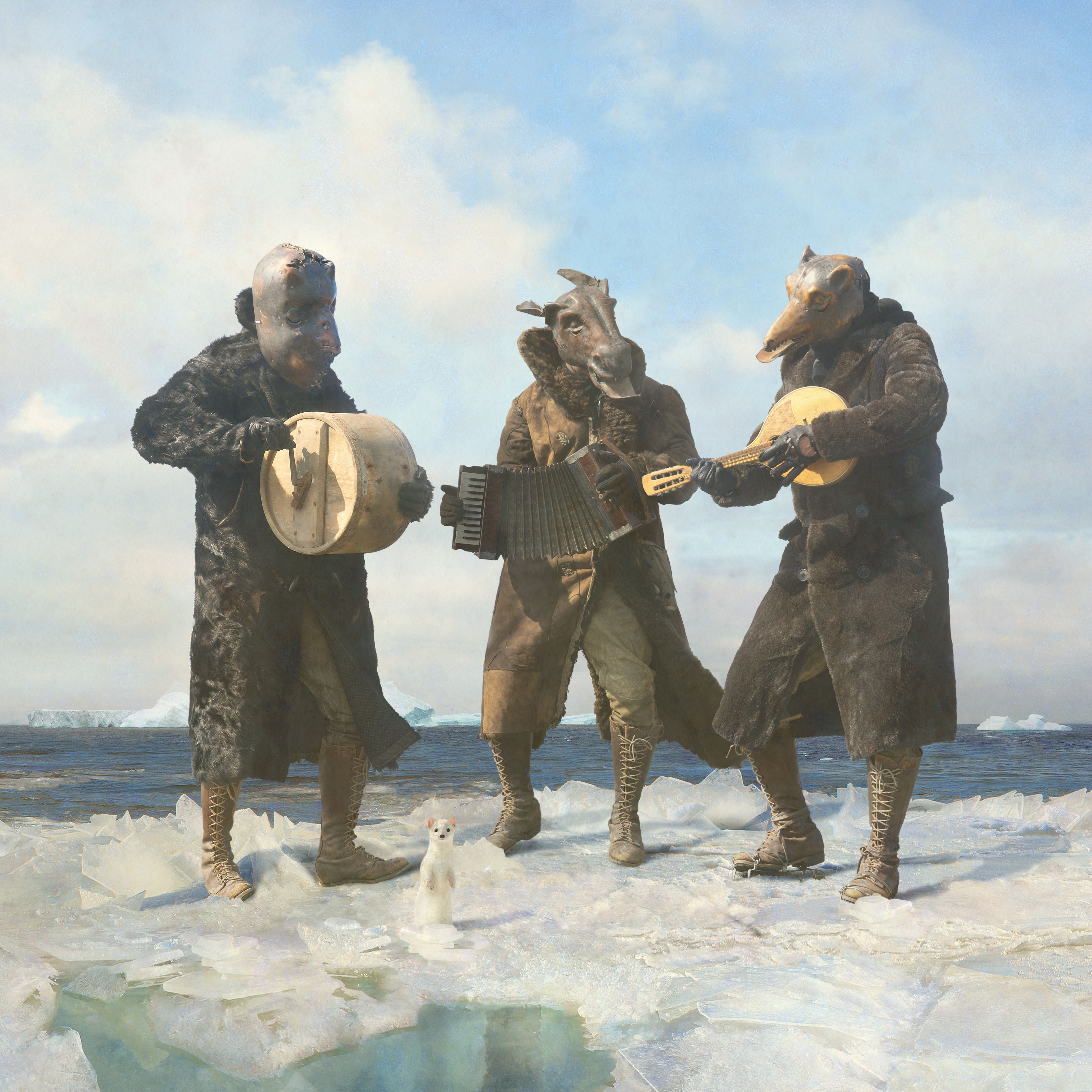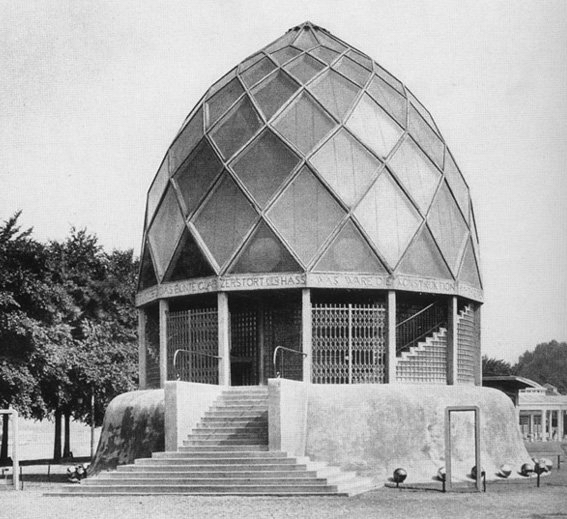Nicholas Kahn (American, b. 1964) and Richard Selesnick (British, b. 1964)
The calving events that set the stage for Eisbergfreistadt are a natural part of the life of a glacier, but the question remains, are rising temperatures and warming oceans eating away at ice shelves more rapidly, causing a loss of ice at a pace that will exacerbate manmade global warming? Because calving is a regular occurrence, glaciologists often hesitate to link the fissures to environmental destruction. Artists Nicholas Kahn and Richard Selesnick are far more direct, though they make their point by constructing a complex narrative to weave together the corporate contribution to climate change with capitalist greed.
The story of Eisbergfreistadt begins on November 17, 1923, when an iceberg, forced off course with unusually strong polar easterlies and carried on the Spitsbergen current, navigated the islands around Denmark and ran ashore at the Port of Lübeck.
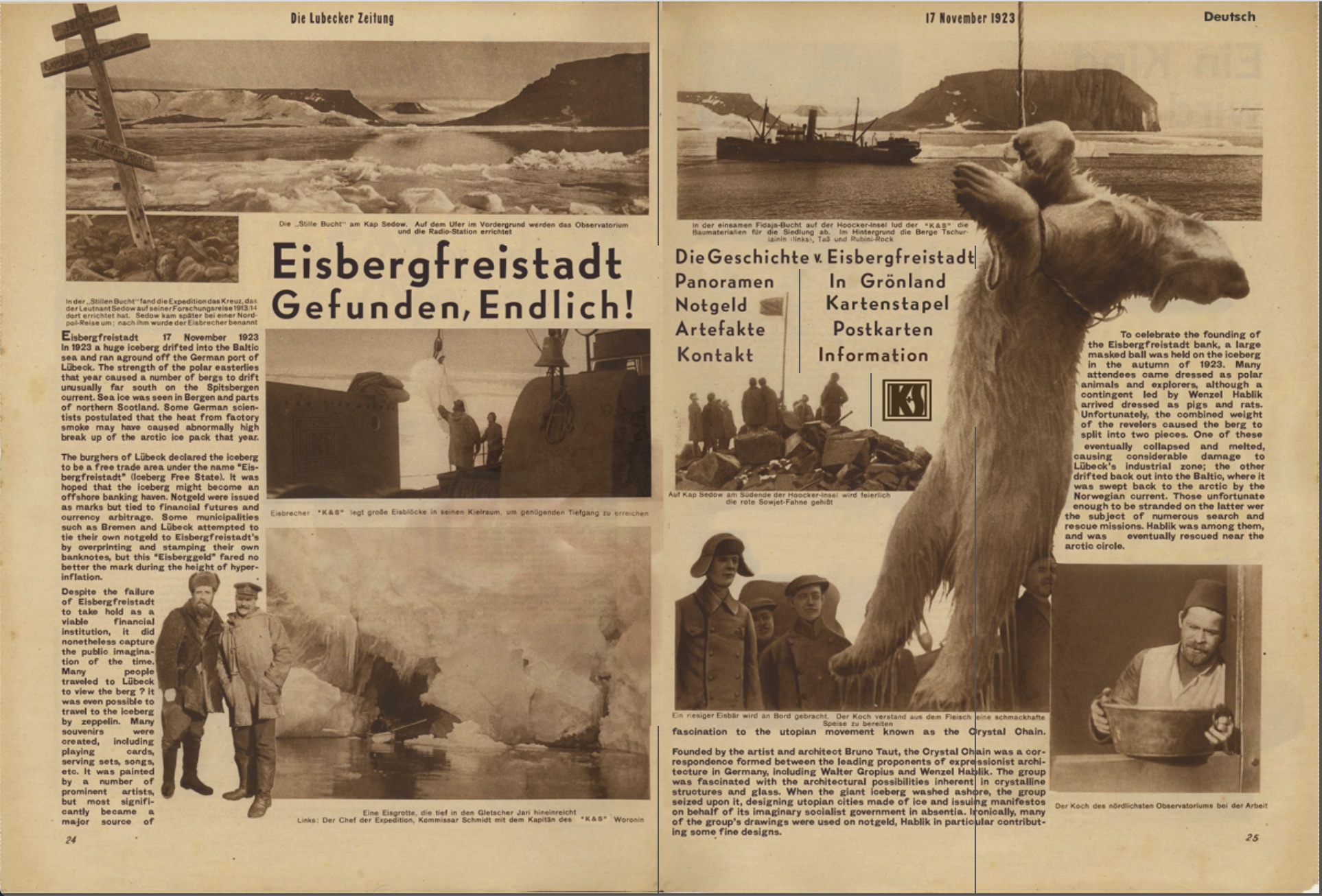
The cause of this phenomenon? According to the documentation, “Some German scientists postulated that the heat from factory smoke may have caused abnormally high breakup of the arctic ice pack that year.”1 But this is only part of the tale. Local officials designated the chunk of ice “Eisbergfreistadt,” or Iceberg Free State, a site of free trade, in the hope “that the iceberg might become an offshore banking haven.”2 This would be accomplished via the printing of notgeld, a valid form of emergency currency that was produced by banks during a period of hyperinflation in postwar Germany, which “were issued as marks but tied to financial futures and currency arbitrage.”3
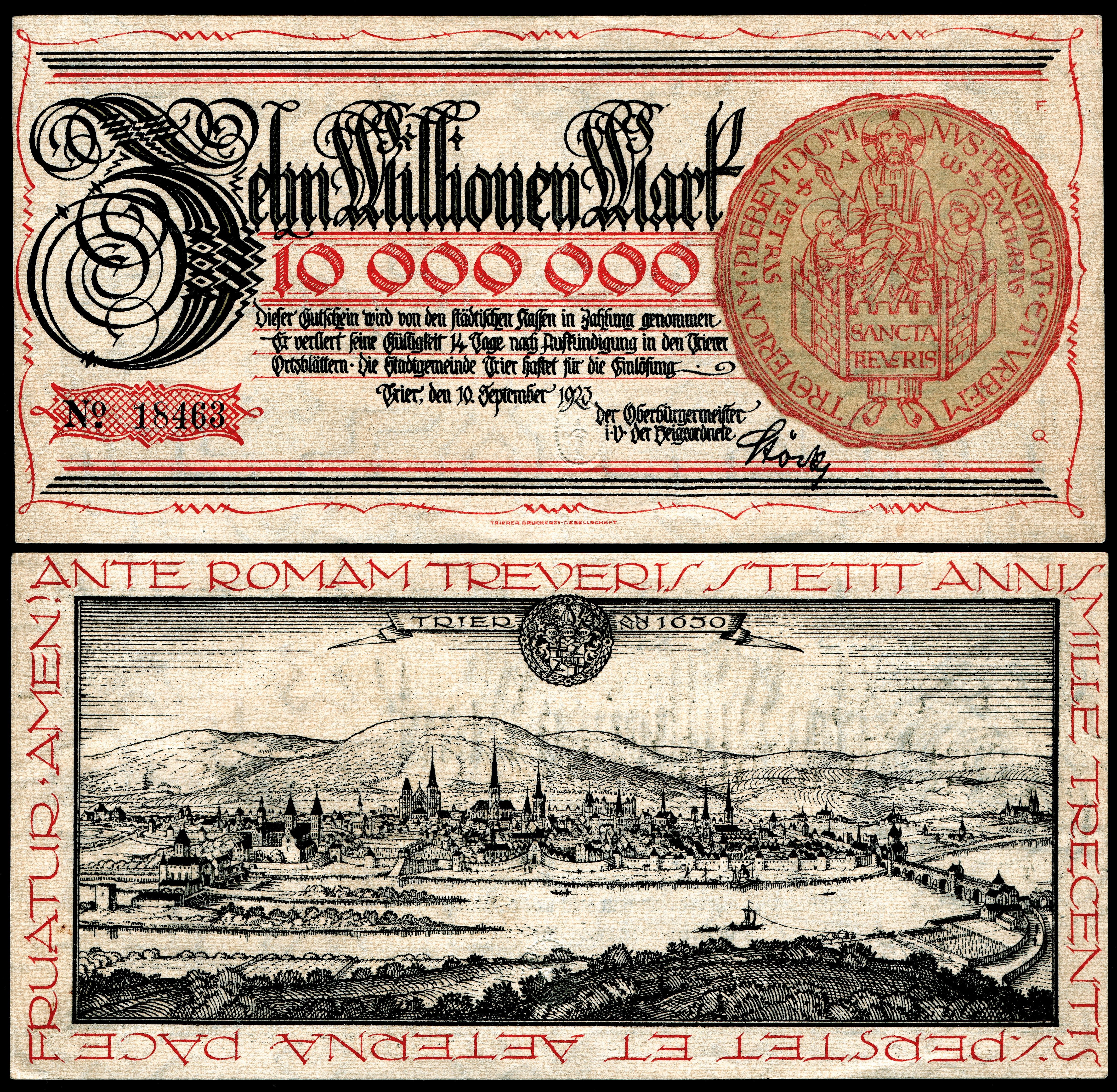
Perhaps the scene depicted in Kartenspiel (2006) best showcases the intersections the event seeks to capitalize upon: a lack of corporate oversight disrupts the environment, which undergoes a physical change that creates a space for a new economy, which collapses because of capitalist greed. Did you get all that? The card players in Kartenspiel sit on boxes and suitcases of notgeld and merchandise, intending to profit from this shocking event. Are there holes in the story? Most definitely. But, does it resonate with the capitalist forces at play throughout society? Most definitely.
Tragedies have long been sources of financial gain, an exchange journalist Naomi Klein calls “disaster capitalism.” For example, beginning in spring 2020 the COVID-19 pandemic spurred lucrative sales in cleaning supplies and disinfectants for people to wipe down their groceries in spite of the evidence that surfaces were unlikely sources for transmission. Jeff Bezos, the founder of and principal stakeholder in the online retailer Amazon, increased his wealth by 40 percent during a moment of record unemployment because shopping from the safety of home was the primary site of commerce during lockdowns. In a broader sense, these are not new revenue streams: private contractors often win government bids to rebuild after natural disasters, and wealth is regularly amassed from the privatization of prisons, detention facilities, and hospitals in the United States. Klein’s shock doctrine theory examines the way in which corporate measures are legislated in the period following a disaster in which the public is disoriented.4
Klein cites Hurricane Katrina in 2005 as an event that is thought of as a natural disaster, despite its most calamitous outcomes having been caused by governmental neglect, racism, and human failure. The displacement of the most underserved residents of New Orleans allowed developers to build trendy condos that “revitalized” the cultural hub of the Louisiana Delta—at the cost of those residents’ homes and public schools, and environmental regulations.5 Mike Pence, then an Indiana congressperson, led the Republican Study Committee, which developed a list of “Pro-Free-Market Ideas for Responding to Hurricane Katrina and High Gas Prices.” Klein states clearly that “the so-called solutions proposed by the group Pence headed at the time were the very things that would inevitably exacerbate climate change and weaken public infrastructure even further. He and his fellow ‘free-market’ travellers were determined, it seems, to do the very things that are guaranteed to lead to more Katrinas in the future.”6 The Eisbergfreistadt series is being made amid this wanton profiteering, so when thinking about the revelers in 3 Musicians, the question that stands out is, are these creatives looking to establish a cultural utopia—or are these “free-market travellers” looking to profit from disaster capitalism? To answer, Kahn & Selesnick’s parafictional Eisbergfreistadt follows a strategy long employed by artists who engage global trauma by blurring fiction and reality or, as art historian Carrie Lambert-Beatty explains, to experience fiction as fact.7 The viewer is put in a vulnerable position: “to go away in a strange kind of educated ignorance, their worldviews subtly altered—perhaps in truthful ways—by untruths.”8
The quasi-historical Eisbergfreistadt is captured in a series of photographs, prints, and objects that force the viewer to look closely, question what they know to be true, and sit in the uncomfortable space of climate change, a surreal circumstance that is disrupting our natural world. The “mistakes,” or ruptures, in the story and in the photographs intentionally make us question reality, in the same way that we question a news story that contradicts what we believed before, pushing us to alter our understanding of the world. This may be among the most unsettling feelings we are capable of experiencing; indeed, as fake news and augmented images circulate through our media, it is clear that some are not capable of rising to the challenge of discerning fact from fiction. Artist Antoinette LaFarge explains that “the fictive art project does not work properly unless cracks of disclosure are left open for the viewer to enter. Once the spectator does pick up on those clues, she is forced into a relationship of play with the work. She can be angry at the deception, or dismissive of the thinness of the reality facade, or charmed by the fictive elaboration (to name only three possible attitudes), but in all cases she must engage with it.”9
Yet although the chaotic mood of the twenty-first century is particularly heightened, economic systems (including the one happening on and around this iceberg) have always been attempts to instill some kind of order on a messy and irrational world, to quantify things that just inherently are not, for example, the idea of “health” via corporate healthcare, or “justice” through for-profit prisons. Disaster capitalism provides a system for quantifying loss and recovery. Eisbergfreistadt, about an attempt to establish that control and the failure to do so, is uniquely situated within And I Must Scream, in which the art displayed depicts the horror or the complications of monsters running wild, beyond human control.
While the Eisbergfreistadt financial experiment ultimately fails, the mythology around it begins to take shape, and the cast of characters becomes increasingly complex. The real-life German architect Bruno Taut (1880-1938), disillusioned by the atrocities of WWI, creates a utopian alternative to recent history, expressed in this story as the “Crystal Chain,” based on his own design of a glass pavilion he envisioned as a cultural center, inspired by the crystalline structures of the iceberg. Indeed, while Taut historically designed plenty of practical housing complexes, he is featured here as a dreamer, where the glass house could have, as art historian Noam Elcott suggests, “no purpose other than the viewing of beautiful forms.”10 What better place to establish a utopian community than on an iceberg? Then again, perhaps there are a number of better alternatives, because the revelers who came to celebrate “caused the berg to split into two pieces. One of these eventually collapsed and melted, causing considerable damage to Lübeck’s industrial zone; the other drifted back out into the Baltic, where it was swept back to the arctic by the Norwegian current.”11 This incredible tale creates a narrative for the monster beyond disruption, one in which pleasure-seekers and speculators are willing to take advantage of destructive systems already in place.
Notes
-
Khan & Selesnick, “Eisbergfreistadt Gefunden, Endlich,” accessed April 28, 2021, http://www.eisbergfreistadt.com. ↩︎
-
Khan & Selesnick. “Eisbergfreistadt Gefunden, Endlich.” Notgeld, or emergency money, is issued by institutions other than the central bank during a crisis to stabilize the economy. German institutions issued notgeld during WWI and the interwar periods. Khan & Selesnick’s story coincides with a moment of hyperinflation in 1922 and the mark was made completely valueless in November 1923 and therefore notgeld value was tied to commodities and foreign currencies. ↩︎
-
Khan & Selesnick. “Eisbergfreistadt Gefunden, Endlich.” ↩︎
-
Naomi Klein, “How power profits from disaster,” The Guardian, July 6, 2017, [https://www.theguardian.com/us-news/2017/jul/06/naomi-klein-how-power-profits-from-disaster] (https://www.theguardian.com/us-news/2017/jul/06/naomi-klein-how-power-profits-from-disaster). See also Klein, The Shock Doctrine: The Rise of Disaster Capitalism (London: Picador, 2008). ↩︎
-
Klein. “How power profits from disaster.” See also Klein, The Shock Doctrine. ↩︎
-
Klein. “How power profits from disaster.” See also Klein, The Shock Doctrine. ↩︎
-
This is not a new strategy; many Greek tragedies create mythical worlds, creating a space to expose real world traumas and the failures of the real to heal from them. ↩︎
-
Carrie Lambert-Beatty, “Make-Believe: Parafiction and Plausibility,” in OCTOBER 129 (Summer 2009): 54-55. ↩︎
-
Antoinette LaFarge, “Eisbergfreistadt: The fictive and the sublime,” Visual Communication Quarterly 16, no. 4 ↩︎
-
Noam M. Elcott, “Kaleidoscope Architecture: Sheerbart, Taut, and the Glass House,” in Glass! Love!! Perpetual Motion!!! A Paul Scheerbart Reader, eds. Josia McElheny and Christine Burgin (Chicago: University of Chicago Press, 2014), 117. ↩︎
-
Khan & Selesnick. “Eisbergfreistadt Gefunden, Endlich.” There is an additional note that some of the revelers were stranded on the iceberg as it made its way back to the arctic circle, including painter Wenzel Hablik, whose crystal-inspired work comprises utopian land- and cityscapes. All were rescued. ↩︎
